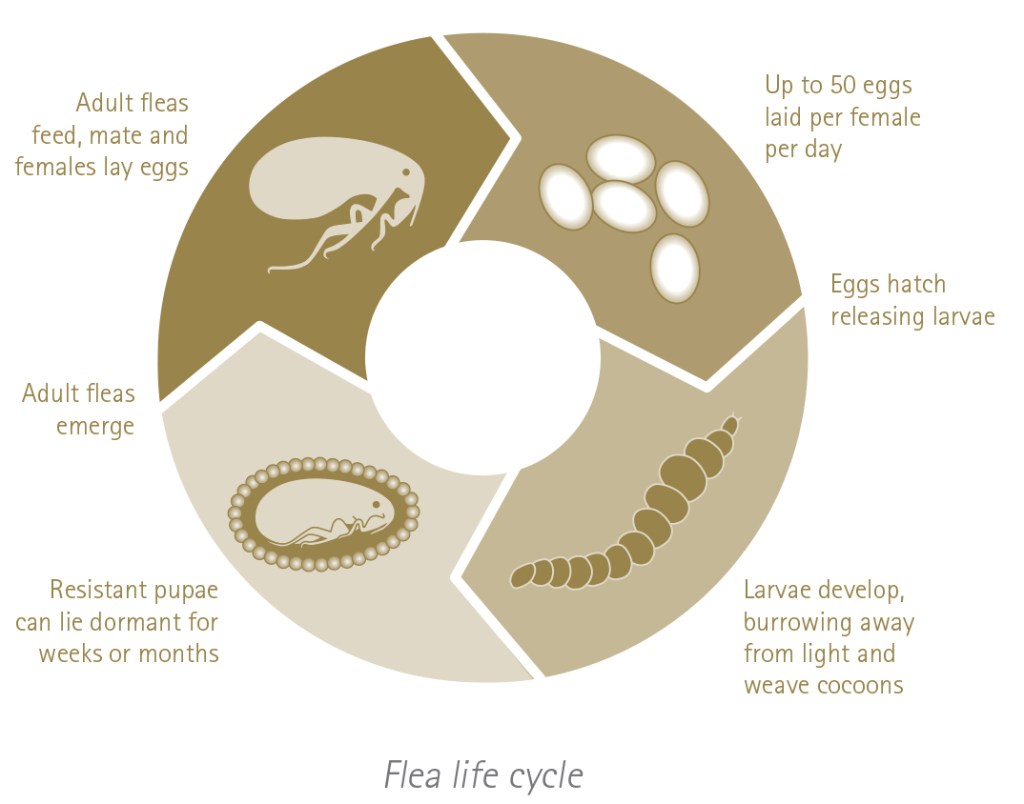
WHAT YOU NEED TO KNOW ABOUT FLEAS
What are fleas?
Fleas are small, 6 legged, blood-sucking, parasitic insects that feed on warm-blooded animals and are the most commonly encountered external parasites of pets. There are more than 2,200 species of fleas recognized worldwide, but the cat and dog flea are the flea species most commonly encountered in Ireland and the UK. All fleas are wingless, so their main mode of travel is jumping. They can jump more than 100 times their own length facilitated by their relatively long hind legs!
How can my pet catch fleas?
It’s a common misconception that pets catch fleas from direct contact with other pets. In fact, this is quite unusual, as fleas tend to stay on the same host and rarely move from one animal to another. Pets actually pick up fleas when they come into contact with an infested environment, so even pets that never come into contact with other pets can become infested.
95% of the complex flea life cycle is found in the environment, including flea pupae, which contain immature adults covered in a protective cocoon. When a pet (or person) passes by, the warmth and vibration stimulate the fleas to emerge from the cocoon and jump on. The pupae can readily survive in sheltered outdoor areas in the right environmental conditions. So if an infested hedgehog, fox or stray pet comes into your garden, and flea eggs drop off and develop into larvae and then pupae, this could become a source of fleas for your pet.

If my pet has fleas, so what?
Fleas are more than just a nuisance and can cause a wide variety of health issues. The most common signs of a flea infestation are related to the irritation caused by flea bites, including scratching and nibbling or biting at the fur. In cats, overgrooming is often seen. Fleas can also cause more severe skin problems in animals which develop an allergy to fleas. This condition is known as flea allergy dermatitis (FAD), and pets with FAD can suffer from intense itching, hair loss and skin infections. Unfortunately, the list of problems doesn’t end there. Severe flea infestations can cause anaemia, especially in puppies and kittens, due to the amount of blood loss. Fleas can also transmit several diseases to dogs, cats and even humans including tapeworm (Dipylidium caninum).
Fleas will also bite people, causing skin irritation and itching, and sometimes triggering an allergic reaction.
What is the life span of the flea?
A single flea can live on your dog or cat for almost 2 months! Flea infestations can rapidly get out of control. That’s because fleas lay eggs in such large numbers. At a rate of 40 to 50 per day for around 50 days, a single female can produce 2,000 eggs! Within as little as 2 days, flea larvae will hatch and hide in dark places on the ground, in carpets or upholstery. After about a week of feeding on adult flea droppings, crumbs, flakes of skin, etc., the larvae spin cocoons to become pupae. The pupae can remain in this stage for very long periods of time. The cycle continues when, as soon as a week or so later, the pupae develop into adult fleas and emerge from their cocoons when they sense that a dog or cat, or other animal host, is near. The cycle, which can take as little as 12 days or as long as 180 days – can then begin again.
How do I know if my pet has fleas?
Fleas are tiny, just a few millimetres long, and very fast moving, so it can be difficult to tell if your pet has fleas. Here are some signs to look out for:
- Scratching. The irritation caused by flea bites can cause pets to scratch excessively.
- Biting or nibbling at the fur. As above, triggered by irritation due to flea bites.
- Overgrooming (cats). In cats, the only sign may be that your pet is grooming excessively, which could also cause hairballs.
- Hair loss, reddening of the skin. In more severe cases, particularly in those pets which develop an allergy, the excessive scratching can cause hair loss and damage the skin, triggering inflammation and infection.
- Tapeworm. Fleas transmit tapeworm, so if you notice signs of tapeworm this could be due to a flea infestation. Signs of tapeworm include the appearance of dried, white to cream coloured segments, or pieces of tapeworm in your pet’s poo or stuck to the fur under the tail (these can look like grains of rice). Pets may also bite or lick the anus, or drag their hind quarters across the floor in response to the itching.
If you think your pet might have fleas, try parting the coat near the base of the tail using your hands or a flea comb and look for movement. Most fleas grow to about the size of a pinhead and will move or jump when disturbed.

It’s not always easy to spot the fleas, and some animals may groom them off. If you don’t see any fleas, have a look for flea dirt; dark, pepper-like particles on the surface of your pet’s skin and coat (see Fig.1). You can easily confirm this by dabbing some of this material with a wet paper towel or cotton ball. If you see dark reddish brown or orange swirls, this is flea dirt and confirms that your pet has fleas.
So how do I control or prevent fleas?
Various products are available for controlling fleas. Your veterinary practitioner is best placed to advise you on the product of choice for your pet. For further information about protecting your pet, click here

